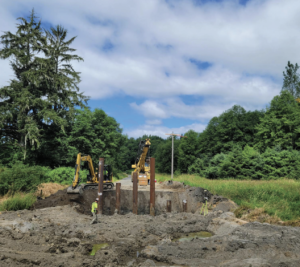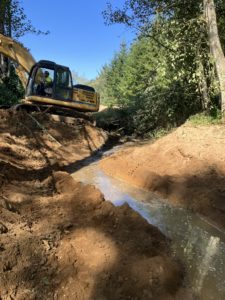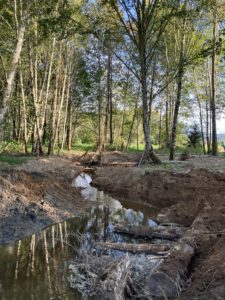Restoration Along the Elochoman
Returning Nelson Creek to its Historic Path To Restore Wetlands and Improve Fish Habitat
Nelson Creek—a tributary of the Elochoman River—was diverted from its historic path into a culvert and roadside ditch for over 70 years. The ditch and culvert were both too small to contain the creek’s winter flows, which led to the over-flooding and decline of an adjacent Sitka spruce swamp and reduced the quality of in-stream habitat for Coho (Oncorhynchus kisutch) and steelhead (Oncorhynchus mykiss) salmon, rainbow trout (Oncorhynchus mykiss), and native lamprey.
 To change that, in May Columbia Land Trust and contractor Evergreen Developers broke ground on a floodplain restoration project that included the construction of a new 50-foot bridge for Nelson Creek to flow beneath and the excavation of about two miles of stream channel and tidal tributaries. In addition to improving habitat for salmonids, the project restored over 150 acres of habitat for threatened Columbian white-tailed deer (Odocoileus virginianus leucurus).
To change that, in May Columbia Land Trust and contractor Evergreen Developers broke ground on a floodplain restoration project that included the construction of a new 50-foot bridge for Nelson Creek to flow beneath and the excavation of about two miles of stream channel and tidal tributaries. In addition to improving habitat for salmonids, the project restored over 150 acres of habitat for threatened Columbian white-tailed deer (Odocoileus virginianus leucurus).
Before restoration, the site had few mature trees and was dominated by reed canarygrass and other weeds. Our work will restore the floodplain to historic conditions, which included an old-growth Sitka spruce swamp, complex marsh channels, and emergent wetlands.
The project required a lot of soil to be moved, as the new main creek channel ranges from six to ten feet deep, old irrigation ditches need to be filled in, and topographic complexity was restored to land that was flattened for agriculture.
“We have historic maps so we knew approximately where Nelson Creek originally ran,” said Natural Area Manager Simon Apostol. “Starting in the 1900’s the creek’s location was altered over the years by agriculture and road construction.”
 Excavation work wrapped up this September, and the newly dug channels filled in with water quickly, thanks to a high water table, daily tides, and fall rains. “Because of the presence of salmon in the watershed, I would expect migrating salmon to find their way into the new channels as soon as this fall,” said Apostol. “The channels we created will allow adult salmon to access upstream spawning habitat and provide a place for juveniles to rest, grow, and feed on their journey to the ocean.”
Excavation work wrapped up this September, and the newly dug channels filled in with water quickly, thanks to a high water table, daily tides, and fall rains. “Because of the presence of salmon in the watershed, I would expect migrating salmon to find their way into the new channels as soon as this fall,” said Apostol. “The channels we created will allow adult salmon to access upstream spawning habitat and provide a place for juveniles to rest, grow, and feed on their journey to the ocean.”
Apostol described what the site will look like as nature continues to shape the landscape; “As willows, spruce, and other plantings grow up, beaver are sure to create numerous dams across Nelson Creek and the tidal tributary channels, which will spread water across the floodplain and increase channel complexity and the amount of in-water habitat available to fish, especially in the winter and spring.”
The next step is the planting of nearly 200,000 native trees and shrubs.
A combination of quick-growing willows and alders and slower growing conifers will provide shade over the streams and Elochoman riverbank. The conifers will eventually drop branches and become logs that will fall into the waterways and provide structure and habitat complexity.
“Additional goals for the revegetation phase of this project include controlling invasive species to promote long-term biodiversity and site health, and providing forage and cover for deer, which prefer to browse shrubs like dogwood, salmonberry, and willows over pasture grasses that have low nutritional value,” said Apostol.
This large construction effort also presented a valuable opportunity in the Land Trust’s ongoing efforts to work with a diverse array of partners and contractors. We were excited to work with minority-owned contractor Evergreen Developers, LLC, led by Jeremy Tjaden, on this important restoration effort. Despite early challenges caused by the extremely wet spring, construction was generally smooth and on schedule.
“Evergreen is a member of the National Association of Minority Contractors of Oregon, a group that has been invaluable in our efforts to develop a new, more inclusive approach to designing and building our restoration projects,” said Stewardship Director Ian Sinks. “These new partnerships have made our work more effective, and we were honored to be recognized by the Portland Daily Journal of Commerce as a 2022 Building Diversity honoree for our work with Evergreen.”
 The lower Elochoman River has long been a priority area for the Land Trust, in part because its location within the Columbia River estuary provides critical habitat for migrating and rearing salmonids from throughout the entire Columbia basin. It is also one of few remaining habitat areas for Columbian white-tailed deer, whose low elevation habitat along has been severely altered by agriculture and urbanization. Nelson Creek and two other Land Trust sites in the lower watershed (totaling about 600 acres) build off conservation efforts at the adjacent 6,000-acre Julia Butler Hansen National Wildlife Refuge, expanding the cohesive deer habitat.
The lower Elochoman River has long been a priority area for the Land Trust, in part because its location within the Columbia River estuary provides critical habitat for migrating and rearing salmonids from throughout the entire Columbia basin. It is also one of few remaining habitat areas for Columbian white-tailed deer, whose low elevation habitat along has been severely altered by agriculture and urbanization. Nelson Creek and two other Land Trust sites in the lower watershed (totaling about 600 acres) build off conservation efforts at the adjacent 6,000-acre Julia Butler Hansen National Wildlife Refuge, expanding the cohesive deer habitat.
“This project builds on a long history of restoration and conservation in the watershed, and after five months of construction I look forward to moving into the planting phase and watching as wildlife move back into the improved habitat,” said Apostol.